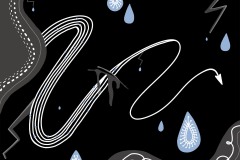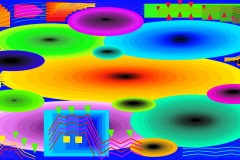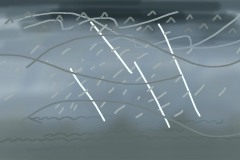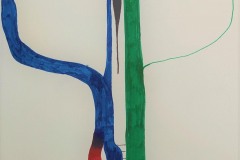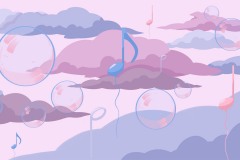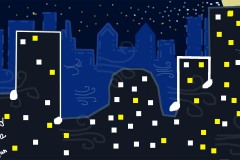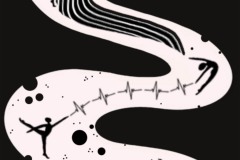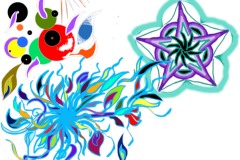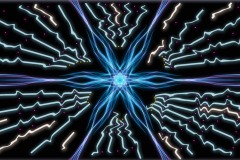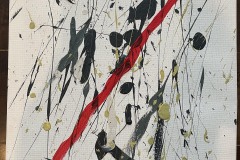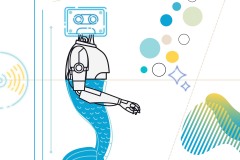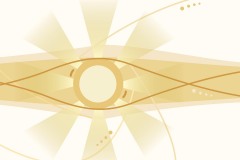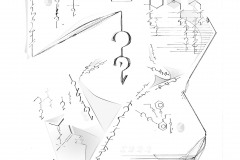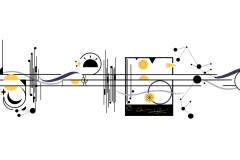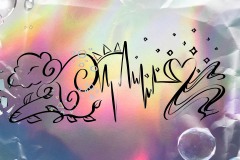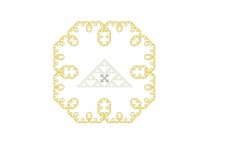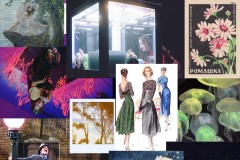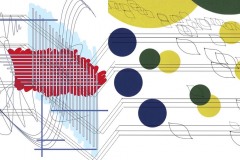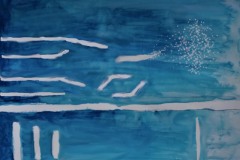
One-Page Score Project w/ University Transition Program students
Live premieres
Session #1: Friday, April 30, 2021; 11AM PDT
Session #2: Friday, May 7, 2021; 11AM PDT
WATCH SESSION #1 WATCH SESSION #2
*** We recommend using headphones or good speakers for the best listening experience. ***
Featuring music by Adrian Avendaño, Sara Gold, Doug Gorkoff, Peki Hajdukovic, Marina Hasselberg, Hitori Tori, Alanna Ho, Viviane Houle, John Kastelic, Constantine Katsiris, Jaewoo Lee, Molly MacKinnon, The Memory Palace, Daniela O’Fee, Jean Routhier, Paddy Ryan, Anju Singh, Emma Tomic, Andrea Wong, Andrea Young.
The One-Page Scores will premiere on Vancouver New Music’s YouTube channel: http://www.youtube.com/user/VancouverNewMusic
Graphic Notation (def.): a rogue representation of music using liberated symbols;
a form of freedom; a visual work of art with transformative aural potential.
This spring, Vancouver New Music will present its biggest One-Page Score Project yet. Giorgio Magnanensi will work with 20 musicians, and 42 high-school students enrolled in the Vancouver School Board’s University Transition Program (in partnership with the University of British Columbia) to create an all new series of graphic scores.
In graphic notation, images, signs and symbols can be used to represent sounds, sonic textures and various kinds of musical events. Using graphic notation, composers don’t need any prior knowledge of how to write or read traditional musical notation – just a desire to create and explore sound.
Guided by Magnanensi, students will learn about and experiment with graphic notation, sound, composition, gesture and figure, then work in groups to create their own One-Page Scores.
Following this introduction, the students created pieces that explore entropy and order, incorporate data visualization, abstract expression, and themes ranging from family to sun cycles, chemistry, movement and sound and more.
For the final workshop session each student group was paired with a professional musician, who will create sonic interpretations of the students’ scores, with each sound artist contributing their unique instrumentation and musical style.
The final creations from each session will be premiered online as live premieres in two sessions on April 30th and May 7th at 11AM PDT. Everyone is invited to tune in and take part in a live chat.
Click ‘+’ in lists below to expand program notes.
Sara Gold (music), Jonathan and Jocelyn (score) - Weathering Difficulties
Our piece was mainly inspired by chaos and brings out chaos and discord without sacrificing the aesthetic or visual appeal. We also wanted to feature perspectives: the viewer can see optimism or pessimism depending on which way they look at the piece. The travelling music staff can be thought of as a downward or upward spiral, spinning towards the dark road that leads to nowhere or spinning away into something brighter. Furthermore, we were also inspired by the weather here in Vancouver that often is so dreary, yet inspiring and calming.
– Jonathan and Jocelyn
Doug Gorkoff (music), Noah and Raymond (score) - Warbling Whispers
Warbling Whispers is a creative use of bold colours and geometric shapes that can convey a variety of different meanings and interpretations. With vibrant colours, the large ellipses are visually the most notable part of the piece. One possible interpretation of the piece treats the ellipses as portals, reflecting upon the idea of time. There are many other objects on the perimeter of the piece, representing events throughout our lives, but ultimately, the portals–time–are central to our existence. Warbling Whispers is a reflection upon how time, although sometimes not the main focus, quickly slips by like a whisper. This piece also allows for other interpretations too!
– Noah and Raymond
This was created using only a cello, running through a series of effects pedals. Various layers were recorded using Logic Pro in real time with minimal editing in post. For the most part, I followed the score from left to right but there are definitely sections where I jumped around to grab various features. For the best effect, I’d suggest listening with good quality headphones. – Doug Gorkoff
Equipment list: Realist Cello pickup, ToneDexter (preamp), Electro-Harmonix Pitchfork (pitch shifter), Fulltone OCD (overdrive), Boss MD-500 (modulation), Boss DD-500 (delay), Strymon blueSky (reverberator)
Molly MacKinnon (music), Vanessa and Emily (score) - Rainstorm
This piece takes inspiration from different elements of weather in Vancouver. The rain, clouds, the waves, and everything else layers up to take the appearance of a full-fledged rainstorm, for which it is named. There is little to no order in this piece, meant to show the unpredictability and chaos of weather. There’s almost no telling what it will be like and there is no pattern in the falling of raindrops, the path of the wind, the shapes of the clouds, or the rising and falling of the waves. They’re inconsistent, they’re slightly wild, and they’re unforeseeable.
– Vanessa and Emily
I had a blast with Vanessa and Emily’s score. It felt very atmospheric to me, like a morning fog rolling in on a grey day in Vancouver. There’s multiple layers of both my voice and violin, and even at a certain point, a shoebox (see if you can guess where it is!)
– Molly MacKinnon
mollymackinnon.ca
Marina Hasselberg (music), Elliott and Kevin (score) - Rivers of time
Rivers of Time is a piece that shows the changes in people over time. As kids grow, they become more independent as they mature, no longer needing as much help from their parents. Sometimes they can even find their parents’ love excessive and unnecessary. Though no one is at fault for increasing the distance between parent and child, the slowly stretching distance is always heartbreaking. However, the wound slowly heals, and as the children become parents, as they pour out their own love to their children, they finally truly realize the meaning of love in the rivers of time.
– Elliott and Kevin
Alanna Ho (music), Anna and Vivian (score) - A World of Pink Bubbles (excerpt)
Centered around the idea of how everything is perfect inside a person’s imagination, A World of Pink Bubbles depicts a peaceful paradise amidst a faded, pale sky. The visual score is composed of several individual elements – fluffy clouds, musical note-shaped balloons, and translucent bubbles. A common trait between them is how they all suspend calmly in the air, with no troubles anywhere near to disturb the serene atmosphere. If only life in reality was as carefree and wonderful as our pastel pink dreams…
– Anna and Vivian
Pop. Layers hide and emerge. I imagine the rising and falling objects illustrated in this lively score as little characters trapped in a frame, a loop. Foreground, background. Seeping and staining. The transparent shapes in the graphic score is interpreted through live coding in Sonic Pi. Multiple loops and samples are used. Headphones recommended as there is a lot of panning. This improvisation was created with no editing to the sound (listeners will see the code as the sounds are playing–errors, thread deaths and all).
– Alanna Ho
Alanna Ho: Electronics, Voice
John Kastelic (music), David, James and Aya (score) - Urban Serenity
Urban Serenity took inspiration from the tranquil and calm atmosphere observed in cities at twilight, as well as the soft, smooth melodies and patterns observed in Jazz music. Slightly based off of Gershwin’s Rhapsody in Blue, Urban Serenity uses thin, smooth, lighter lines to convey stringed instruments and slow, round patterns, whereas larger curved lines represent the full, sonorous tones of bass strings such as the double bass and cello. The background is inspired from the city skylines of cities like New York, with the foreground indicating the melody pattern and the background communicating the harmony and other pieces.
– Ayan, David and James
Thank you to David, James, and Ayan for this beautiful score. I interpreted the score as an urban nocturne. The foreground buildings of the score I took to be the main elements, rendered as three substantial sound events. The music notes that frame some of the buildings were loosely interpreted as scraps of melody, borrowed here from the first movement of Shostakovich’s Violin Concerto #1, which is a beautiful but desolate nocturne and one of my favourite pieces these days. The lit windows, mirrored by the stars, correspond to the plucked sounds, which I meant to represent specks of distant light. Whistling wind sounds are also heard throughout, moving between the buildings. All sounds originated on the viola. Most were played through guitar pedals, with additional processing at the computer.
– John Kastelic
Daniela O’Fee (music), Alice and Sheena (score) - The Dragon’s Ballet
Demonstrating the moments of joy in our life, this piece is titled The Dragon’s Ballet. The star of this piece is inspired by a bearded dragon, our class mascot, and symbolizes the joy and love which we feel for our school. The winding tail represents our long journey that we are experiencing with our program with all of its twists and turns. The inside of the tail features dancers, illustrating a different way to experience music, as well as representing our passions for creative expression, and how they overlap with our academic journey. The dancers are in motion, demonstrating how our hobbies and interests are also dynamic and constantly changing with time. Lastly, different textures and designs visualize the relationships and connections we make along this path. The colour scheme is black and white to create sharp contrast and highlight our experience and movement through an uncertain world.
– Alice and Sheena
The bearded dragon is a class mascot that promotes happiness and joy. On the piano, I arpeggiated positive, robust sonorities to outline the black serpentine shape allowing the sound to seep in through the pores of the white silence. Departing from the bottom of the plane, embellished dancers spring forth, but as the texture becomes more saturated with electronically induced undulations, the final dance figure promotes a calm end.
– Daniela O’Fee
http://www.youtube.com/channel/UC0jVMB4K8-gfAaiyuKxEeBg/videos
The Memory Palace (music), Cora and Shaana (score) - Eccentricity
Our piece was named Eccentricity for the feeling it gives. It’s bright, it’s bold, and it’s unpredictable. The piece was not inspired by one particular emotion or place, but instead an exploration of the elements of art and how they can be translated to music. One of the first things that come to mind regarding our piece is its abstract and colourful nature. The colours create a bright, exciting atmosphere that is displayed throughout the whole piece. Many aspects of the artwork also appear symmetrical, which can be repetition or structure in the music. The wide variety of shapes show dissonance but also harmony and flow in the music, from the straight lines in the star to the more flowing, rich petals and shapes to the left. The work is divided into three main phases, and their connection allows for a more unique interpretation by forming melodies that each have distinct qualities, but are also able to be combined into one main musical piece.
– Cora and Shaana
Score performed by The Memory Palace on modular synthesizer – April 16-22, 2021.
Emma Tomic (music), Arran and Nora (score) - Perspective
Our score was made to represent the relativity of reality and space-time. One story, one existence, can be interpreted by others in many different ways, and each of them can be true. A civilization can grow and evolve, and to those who lived in it, will have left a mark on the universe, but to an outsider, they might not have existed at all. Parts of our score repeated, and the score was almost rotationally symmetric, but not exactly. If you look closely, there are small differences in how the “lines of space-time” curve, showing the minute distinction between everyone’s perception. All the lines, including the tendrils of blue and purple, spread out from one point, signifying the increasing entropy of the universe, and divergence from what actually occurred (if there is only one truth, of course).
– Arran and Nora
With a beautiful score by Nora and Arran leading us into deep space, this composition was made using eurorack modules, specifically the All the Colors of Noise by Martin Howse which is an ourorack noise voice, inspired by alchemy and the Ripley Scroll. Other samples procured using WebSDR, an online radio receiver.
– Emma Tomic
Andrea Wong (music), Sara and Michael (score) - Journey of Dreams
The central theme of this piece can be interpreted as a journey resembling a dream, starting from the coil in the upper right sector and branching off onto two distinct paths, each leading somewhere different, in which the traveler comes across strange things that people might see when they are dreaming. However, you could also see the road starting from one of the diverging paths mentioned earlier and progressing towards the other. This piece also deals in sectors quite a bit. Although the background is mostly a bluish purple, you can clearly see three sections, the one on the left, which is both blue and purple, the purple one on the top right, and the blue below it. Also, the light opacity of the background gives the piece an uncertain and dreamlike quality, making it seem like the zone between reality and pure imagination.
– Sarah and Michael
The overall blue-purple tone of Michael and Sarah’s score inspired me to find something sonically shared – the instrument choice – between the three main grids which I interpreted as three sections. I felt a general tone of abstract nostalgia with wistfully neon interruptions. I wanted to capture the score’s charming elements of scattered chaos, and was guided by many complex layers, bright colours, and periods of space between components. Exploring each of the three dimensions by following the hazel line, I experimented with layering recorded acoustic piano to reflect various sustained motions, washes of transparency, and shimmering figures.
– Andrea Wong
Adrian Avendaño (music), Huxley, Irene and Miranda (score) – Decisive Entropy
Chaos – the driving force of the world. Through random generation a pattern appears.
Our piece is heavily inspired by chaos and entropy, taking inspiration from splatter paint artists and letting the image guide itself. Decisive Entropy was made in a physical format, outside, to enhance the unpredictable nature of the piece, as digital work would ruin or distill the ideas we tried to convey.
Then, there’s the red line, cutting through the chaos, a beacon of indifference in a sea of calamity. Fate, life, death, entanglement, the line represents what you want it to.
– Huxley, Irena and Miranda
Decisive Entropy is a culmination of the complex and unruly sensations the image and title evoke. The contradiction of having an assertion or clarity in something chaotic or random inspired me create an atmosphere of continuous discontinuity. I did this using by layering recordings, with each take being inspired by the different element of the image.
– Adrian Avendaño
Viviane Houle (music), Laura and Amy (score) – Ocean’s Mirror
A mirror that shows what human civilization is up to: the fumes in the air, the carbon footprints, the rising ocean levels — only the oceans witnessed everything. The ocean shows how carbon emissions have caused glaciers to melt in the Arctic, and rising sea levels are soon swallowing islands into the depths of the Pacific oceans. The ocean shows how man-made garbage patches and pipelines are endangering entire ecosystems and killing off species. The ocean also, however, shows human exploration. In our score, we decided to use elements of cyberpunk and electro funk to incorporate our aspirations for future technological developments. We also included older technology, such as a cassette tape, into our score to represent the rapid evolution of music and the quick replacement of technology. As scientists slowly uncover the darkest secrets underwater, humans get a more thorough understanding of the Earth’s mysterious corners. Follow us into this journey of musical exploration…
– Laura and Amy
Improvisation and working with materials at hand are my interests right now in terms of composition. Very grateful to James for the sounds and mixing, Amy and Laura for the inspiring and beautiful graphic score, and VNM for this opportunity to collaborate and share.
– Viviane Houle
Viviane Houle: voice, chromatic bells, bird whistle, plastic doggy bag, toy megaphone, guitar pedals
James Meger: piano, chromatic bells, toy megaphone
Recorded on Zoom H4n with Neumann (KMS 105) mic in my living room.
Arrangement: Viviane Houle
Mixing/mastering: James Meger
Hitori Tori (music), Mia and Emilie (score) – 5778K
Inspired by the restorative joys of springtime and summer, 5778K was named for the temperature of the sun, the main focal point in our piece. Light colours and long, flowing shapes and lines highlight the warm feeling of summer we tried to convey. The graph in the background was composed of graphs of Vancouver’s sunrise and sunset times over the year, and the swirling shapes evoke the rays of the sun. Digital collaboration tools allowed us to send our edits back and forth as we made changes to the piece, streamlining the artistic process.
– Mia and Emilie
Jaewoo Lee (music), Kevin and Joanna (score) – aronin organometallics
Our story dives into the organic chemical world through the mystical language of Aronin, beginning with the alkanes. A pause; then halogens in a bolt of UV radiation strike down upon them. The radical grows on a stable site but doesn’t stop there. Below, the alkenes add across the double bond, or snuggle close to the N-bromosuccinimide, as in an aromatic halogen substitution. Finally, nucleophilic hydrogen halides attack the tertiary alcohols with substitution 1, while PBr3 and SOCl2 take care of the lesser alcohols.
Now they become organohalides.
“Careful on the phrase-closing tick – it’s splintering into a polymer staff.”
A phrase made of two connected question marks represents RX. In ether, Mg comes between the carbon and the halogen, Li+ liberates the halogen, and a Cu holds two chains to itself negatively. The Grignard reagent rests at the bottom — it lets go of metals, makes more ether, adds to organohalides. After some carbonyls, they both become alcohols again.
“Things are blowing up on the way back…”
– Kevin and Joanna
Peki Hajdukovic (music), Vlad and Ebrahim (score) – yve's eyes
As we glean information from data, so do we learn from images. Yve’s Eyes uses the fundamental structure of a group conversation to guide itself, as emotion, chaos, and activity are all depicted through shape and frequency. The static score of time acts as a background to the constant evolution and dissection of ideas, while points, lines, and shapes in this continuum all serve to convey the essence of a large, free-spirited interaction. With Yve’s help, the code we used to collect and distill the data, the idea of community was conveyed graphically and succinctly.
– Vlad and Ebrahim
Constantine Katsiris (music), Verna and Sophia (score) – Life’s Journey
This piece represents the intricacies of life. Meant to be read left to right, the composition portrays the various stages of life through creative symbolism. The cloud represents the starting of our lives, while the swirls represent the whimsy of childhood, emphasized by the coloured shapes, which bring youth and playfulness. As well, the vines and leaves represent the growth, both physical and emotional, that happens during childhood up till adulthood. The fluctuating heartbeat-like lines represent the beginnings of turmoil and stress that come with adulthood, and the many problems and responsibilities that may come with. They also resemble mountains, symbolizing the perseverance and the hardships we overcome and climb past. Finally, the heartbeat comes to a halt, showing the ceasing of a life, while the wavy lines hold a mystical quality, show our ascension into the afterlife and the unknown. Stars and the night are also often used as a symbol of death, which adds to the idea of the ending of life.
– Verna and Sophia
Jean Routhier (music), Erik and Michael (score) – The Imperfect Infinity
The inspiration for our piece came from the different qualities of music: the rhythmic, orderly, structured pieces of the Baroque and the expressive, dynamic pieces of the Romantic. Fractals were chosen to convey this feeling as we felt they represented the innate beauty in structure, while the different coloured shapes are inspired by characteristics of certain instruments, from a monotone and structured bass to the wildly expressive singing of a melody. A slight asymmetry can be seen, representing moments of dissonance, moments of freedom to express yourself freely. After all, music is a medium of expression and communication between people, and people are rarely ever so perfect.
– Erik and Michael
The graphic score evoked a kind of hypnotic mandala, a map translating organic formation into a stylized patterned reminiscent of mosaic art.
Three different sections I could identify were separated but shared what seemed to be an infinite space. I interpreted the numbers of repeating forms I could decipher as guides: 8, 6 , 3, 4, 5…
I read the score from the centre element (that I ominously nicknamed “black flake”) and started trying to pin down what that anchor could be. Since the software I was recording with uses a linear framework, I put the elements of “black flake” around the 5min mark, mindful the final piece shouldn’t exceed 10min, even though it felt like it could go on for hours, or years.
The sharpness of the drawing (many dots as opposed to washes of colors, or opaque regions) inspired me to use short elements, repeating but never exactly in sync; I relied on the suggestion of the title (imperfect..) to purposefully “trip” myself and concentrate on what I was hearing/ creating as opposed to “fitting” new sounds within the previous elements or trying to build anything to sound a particular way. It got pretty gnarly…
From my notes during our meeting that suggested “baroque era”, so I performed different virtual instruments with a certain baroque flavor (organ, bassoon, choir, oboe, harp, etc). Many of the instruments get in a trance and morph throughout while others make only brief appearances. I tried to follow their suggestions to achieve a balance between the darker more relaxing and the brighter elements. Once I had the framework I mostly proceeded to modify the sonic qualities to achieve other sounds that I felt more unique and befitting the drawing. As these characteristics emerged I was able to find the movement of their depth and their placement in the stereo field. Somewhere along the creative process a more contemplative aspect emerged, which I found to be in line with what mood the score suggested to me.
– Jean Routhier
Paddy Ryan (music), Susanna and Sophie (score)
I did a somewhat linear interpretation, starting from the tree in the middle and spiraling out counterclockwise through the images….. It is a bit intense but I just went with it. The “score” itself never lets up so why would I?
– Paddy Ryan
Anju Singh (music), Yasuto and Matin (score) – chao renascor
In this piece, the duality of nature and the elements is contrasted to form a singular piece of music. The elements on the left of the page show the chaos of entropy, while the right elements of nature represent the formation of something out of the chaos. Displaying the contrast between nature and entropy –– the colors represent the ideals of chaos with interrelated scribbles on the left, while synchronised circles on the right represent harmony of ideas converging together. A singular staff runs though both sides of the piece, establishing a theme of continuity and change.
– Yasuto and Matin
I approached this score by using the vertical orientation (top to bottom) to represent time (I chose to read and perform the score top to bottom) and left and right to represent space (left/right pan). Sections of the score depicted on the very left/very right are hard panned left/right with the objects in the centre being centre panned. The blue, yellow, and green dots are mapped to volume to reflect the size of the circle, combinations of notes based on colour, and position (pan). The most exciting sections that can be heard in the piece are credited to the chunks of red, yellow, and blue on the left hand side as well as the various lines. These sections of the score pushed me to add the textures and large sections of swelling sounds that can be heard throughout the piece.
– Anju Singh
Andrea Young (music), Peter and Eric (score) – Harmonies
Harmonies is a blending of modern art and music. The graphical score’s blue background and white accent takes inspiration from Onement VI by Barnett Newman, an abstract expressionist known for his artistic exploration within colour fields. The melodic line and style of composition resembles Metastasis by Iannis Xenakis’ avant garde graphical music. By combining physical and digital artistic techniques, it was possible to give the white accents a sense of blankness, suggesting a sort of negative harmony contrasted with the droning blue.
– Peter and Eric
The Dream of Sowing Seeds of Excellence: The University Transition Program
How did the dream to provide gifted and talented adolescents with appropriately challenging learning opportunities become a highly lauded educational environment where students thrive mentally, academically, socially, physically within a cohort of peers who invest in meaningful relationships and a caring community, taking responsibility for development of abilities of self and other, and ultimately propelling each other to achieve success in university studies, navigate exciting career pathways, build loving families while contributing their talents and gifts to society for the welfare of future generations?
Initiated in 1993 by the Vancouver School Board in partnership with the Office of the President of The University of British Columbia and subsequently funded as a BC Provincial Resource Program by the BC Ministry of Education in 1995, the University Transition Program designed a radical academic acceleration preparation for early entrance to university studies for BC adolescents in accordance with the BC Special Education Policy for gifted students whose asynchronous educational and developmental needs exceed available services in regular classrooms.
The University Transition Program annually enrolls 20 new BC academically gifted adolescents, ages 13-15, in a two-year preparation for early entrance to university studies. The conceptually advanced, rigorous, fast-paced curriculum promotes high standards of academic excellence, a strong work ethic, and research skills and study habits needed to support success in university studies and future careers. A strong community composed of dedicated students, parents, staff, program graduates, and UBC professors cultivate a pre-university culture of collaboration, leadership, and respect for self and other. The program’s distinctive learning environment combines accelerated learning and educational innovation to optimize talent development while addressing the educational, developmental and social-emotional needs of all members of the community.
UTP offers senior secondary courses extended and enriched in accordance with unique learner profiles, peer to peer learning, and communiversity experiences that build on student intellectual curiosity, passion for problem solving, speed of processing, prior knowledge, personal stamina, goals, and perseverance. The steep two-year learning trajectory begins with an orientation to accelerated learning strategies including time management, planning and organization skills and an introduction to interdisciplinary learning connecting disciplines of English, Mathematics, History, Biology Chemistry, Physics, Social Justice, and Psychology. The second year of the program focuses on intensification, creative and critical problem solving, knowledge applications, high standards of scholarship and research with commitments to community service and/or work experience.
The strong collaboration and community support that students offer one another promote a strong work ethic, enjoyment of shared passions, and enthusiasm for continuing the breadth and depth of advanced curricular learning. Teachers work with students to develop the required knowledge and skills necessary for university studies, while compacting and streamlining curriculum and differentiating to support the learners’ unique profiles. Gratitude at UTP is expressed regularly and used as a means for reflection on the communiversity-style cohort experience. Self-awareness, confidence, social-emotional wellness, academic excellence, and readiness for university studies are core learning objectives.
PROGRAM GOALS
- Personalized preparation for achievement of early entrance to university, successful university studies and exciting career pathways that encourage invention for positive futures.
- Development of character, integrity, compassion, global citizenship, and environmental stewardship through collaborative problem solving and social responsibility.
- Transformation of interests and passions to opportunities to engage with tantalizing and most challenging problems and fine elegant solutions help build meaningful and healthy lives for self, other, and all people.
CORNERSTONES
- Radical academic acceleration
- Social-emotional and character development
- Career exploration & interdisciplinary learning pathways
Unique in BC and Canada the University Transition Program continues to welcome visitors from all over the world.
The One-Page Score Project is a popular ongoing series of workshops and presentations that introduces participants to graphic notation and art music. With the One-Page Score Project we wish to foster open creative expression and collaboration amongst all participants. Vancouver New Music offers the One-Page Score Project and other workshops and community events throughout the year. If you’re interested in finding out when our next one happens, keep in the loop by signing up to our email list.
Top image: Scores by Year 1 and Year 2 University Transition Program students, 2020-21.



